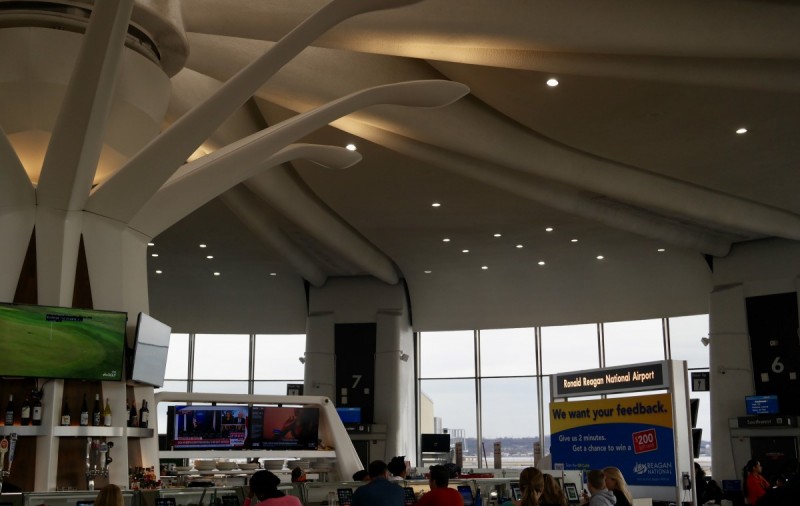Building of the Week: Terminal A at National Airport

The ceiling decoration of the satellite is reminiscent of that in the TWA Flight Center at New York's JFK airport. Image by the author.
The majority of travelers through Ronald Reagan Washington National Airport pass through the much admired Cesar Pelli-designed Terminal B/C, with its Jeffersonian domes and sweeping views of the Potomac River and Washington, DC. However, the concourse in often-less appreciated Terminal A offers passengers a 1960s jet-age modernist backdrop to their flights.
The nine-gate satellite in Terminal A, often referred to as the “banjo” for its comparable shape, is located on the southern end of the terminal complex at National. Built by Northwest Airlines and Trans World Airlines (TWA) for their own use in 1970, it houses four airlines today, including the airport's second busiest Southwest Airlines.
A Northwest map of the Terminal A banjo in 1992. Image by the author.
A terminal to keep up with growth
Northwest and TWA built the Terminal A facilities in response to the growing passenger numbers at National during the 1960s. Traffic more than doubled to 9.8 million passengers in 1970 from 4.7 million in 1960, Metropolitan Washington Airports Authority (MWAA) data shows.
The Terminal A satellite, built in 1970, is primarily used by Southwest Airlines today. Image by the author.
“During the past 15 years, there has been virtually no increase in passenger facilities at Washington National. Those facilities have reached the saturation point,” said George Spater, an executive vice-president at American Airlines, in the Washington Post in July 1966. American opened its own concourse — since demolished — at National in 1968.
An aerial view of the Terminal A satellite in the 1980s. Image by MWAA._800_534_90.jpg)
The Northwest/TWA unit terminal — which included its own curbfront, check-in, and baggage claim lobby as well as the concourse — was built as an “interim” extension of the historic main terminal that opened in 1941, the National Capital Planning Commission (NCPC) says in the minutes of its March 1967 meeting approving the project.
A jet-age concourse
The banjo is described as a “long unfenestrated concourse (with some relief) and a generously glazed satellite,” in the nomination of the historic Main Terminal to the National Register of Historic Places in 1995. “The pier/satellite configuration of this terminal is one of National's most notable features.”
The rotunda of the Terminal A satellite. Image by the author.
The concourse is built out of concrete and glass in the jet-age modern style characteristic of the 1960s. It includes elements reminiscent of the iconic Eero Saarinen-designed TWA Flight Center at New York JFK International Airport that opened in 1962, including the terminal connector and satellite ceiling.
The concourse's nine aircraft gates are connected to the satellite by hulking pylon-like concrete protrusions that, from the exterior, recall many of DC's brutalist federal buildings.
Aircraft gates are connected to the Terminal A satellite with pylon-like concrete structures. Image by the author.
“Its striking design, incorporating skylights and a circular boarding area, features lots of things to make your travels easier,” Northwest said on the banjo in an ad in The Evening Star newspaper in 1972.
A Northwest ad touting its new terminal at National airport in 1972. Image by The Evening Star.
Giuliani & Associates designed the concourse, MWAA documents show. The firm later designed the Interim Terminal in hanger 11 that was used during construction of Terminal B/C in the 1990s.
Continued use
MWAA continues to invest in Terminal A and the satellite. The check-in lobby was renovated in 2010, and a new security checkpoint and concourse concessions were completed in 2014.
The Terminal A check-in lobby was remodeled by JetBlue in 2010. Image by the author.
These investments, and the fact that Washington National needs all of the aircraft gates it has, ensure that this jet age modernist gem will continue to serve air travelers to the region for years to come.
